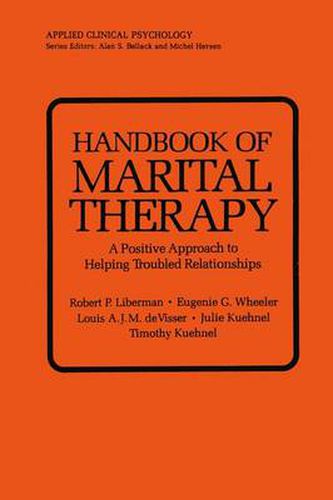Readings Newsletter
Become a Readings Member to make your shopping experience even easier.
Sign in or sign up for free!
You’re not far away from qualifying for FREE standard shipping within Australia
You’ve qualified for FREE standard shipping within Australia
The cart is loading…






This title is printed to order. This book may have been self-published. If so, we cannot guarantee the quality of the content. In the main most books will have gone through the editing process however some may not. We therefore suggest that you be aware of this before ordering this book. If in doubt check either the author or publisher’s details as we are unable to accept any returns unless they are faulty. Please contact us if you have any questions.
In the treatment of marital problems, behaviorally oriented and com munication oriented approaches have been in conflict and seen as con trasting and unlikely bed partners. Many therapists, focusing on com munication skills, have felt that behaviorists were too structured and uncaring; on the other hand, behaviorists have considered humanistic therapists as being touchy-feely, vague, and unfocused. However, in the Handbook of Marital Therapy, Liberman, Wheeler, de Visser, and the Kuehnels have wedded these two potent approaches into an inte grated framework that makes them loving bed partners. With over a decade of experience in applying behaviorally ori ented treatment to couples, Liberman and his co-authors have devel oped an educational model that focuses on teaching specific commu nication skills to couples. The communication skills they describe have been used extensively in all types of marital therapy, regardless of the therapist’s theoretical orientation. The unique contribution of this book is that the authors provide a step-by-step approach to teaching these communication skills within a behavioral framework. Each chapter guides the therapist through the many issues and problems confronting him or her as a change agent. This highly readable book is enhanced by a liberal use of case exam ples. Emphasis is given to homework and structured sessions that focus on increasing specific communication skills in a sequential manner. The advantages of working with couples in a group setting are dis cussed, and concrete suggestions on how to manage these groups are clearly presented.
$9.00 standard shipping within Australia
FREE standard shipping within Australia for orders over $100.00
Express & International shipping calculated at checkout
This title is printed to order. This book may have been self-published. If so, we cannot guarantee the quality of the content. In the main most books will have gone through the editing process however some may not. We therefore suggest that you be aware of this before ordering this book. If in doubt check either the author or publisher’s details as we are unable to accept any returns unless they are faulty. Please contact us if you have any questions.
In the treatment of marital problems, behaviorally oriented and com munication oriented approaches have been in conflict and seen as con trasting and unlikely bed partners. Many therapists, focusing on com munication skills, have felt that behaviorists were too structured and uncaring; on the other hand, behaviorists have considered humanistic therapists as being touchy-feely, vague, and unfocused. However, in the Handbook of Marital Therapy, Liberman, Wheeler, de Visser, and the Kuehnels have wedded these two potent approaches into an inte grated framework that makes them loving bed partners. With over a decade of experience in applying behaviorally ori ented treatment to couples, Liberman and his co-authors have devel oped an educational model that focuses on teaching specific commu nication skills to couples. The communication skills they describe have been used extensively in all types of marital therapy, regardless of the therapist’s theoretical orientation. The unique contribution of this book is that the authors provide a step-by-step approach to teaching these communication skills within a behavioral framework. Each chapter guides the therapist through the many issues and problems confronting him or her as a change agent. This highly readable book is enhanced by a liberal use of case exam ples. Emphasis is given to homework and structured sessions that focus on increasing specific communication skills in a sequential manner. The advantages of working with couples in a group setting are dis cussed, and concrete suggestions on how to manage these groups are clearly presented.